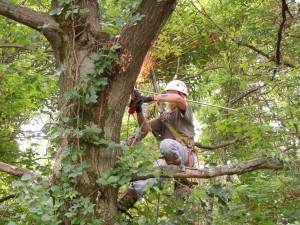Cabling and Structural Bolting


Even trees that are routinely maintained may develop weaknesses that affect their own safety and that of people and property.
Proper pruning can shorten, lighten and thin hazardous branches.
And yet in some cases, this may be inadequate to keep certain limbs or trees safe. Trees can grow in such a manner that their physical structure can no longer support their own weight.
This is particularly common in mature multi-trunked trees and trees with open canopies.
Whether an unsafe tree structure is due to lack of proper pruning or the natural growth inclination of a tree, cabling and bracing may be required to reduce stress.
Cables and bracing rods are tools arborist use to protect or improve the structural integrity of trees.
Cabling involves the attachment of a steel cable or a Cobra cabling system between branches to limit excessive limb motion and to reduce stress on a union or branches.
Sometimes trees are cabled together for support. Bracing uses bolts or threaded rods to rigidly secure weak or split crotches, unite split trunks or branches and hold rubbing limbs together or apart.
Inspection of cabling at least annually is very important to check the cable tension and the stability of the hardware. If a tree is vigorously growing, you may need to raise the cabling in eight to ten years to provide adequate support.
Contact Green Leaves Tree Service today at 219-877-8263